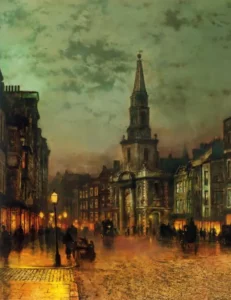Victorian painter John Grimshaw Atkinson gained recognition for his gloomy depictions of sceneries and the midnight paintings of city streets with barren trees lined up alongside the night sky. In time, Grimshaw became acquainted with James Whistler; the latter came to confess that up until he saw his buddy’s painting of the moon, he had thought of himself as the best creator of nocturnes. Yes, Whistler believed his work was perfect until Grimshaw turned up.
Grimshaw, a Leeds native and the son of a former police officer, began painting while working as a clerk for the Great Northern Railway. In 1858, he wed Frances Theodosia, a close relative; three years later, he’d started focusing solely on his artistic career. John Atkinson Grimshaw’s paintings included the meticulous Pre-Raphaelite modeling of renowned artist William Inchbold; the latter imitated Ruskin’s widely respected classical impressions.
In constructing his compositions, he may have utilized a camera obscura as he was also captivated by the still-developing field of photography. He abandoned this painting method around 1865. Moonlight and shadows were the most striking elements in many of his cityscape compositions that won admiration.
His Favourite Towns
He regularly portrayed cities like Glasgow, Whitby, Scarborough, Leeds, and Liverpool, aside from London’s major harbors. He also painted sceneries, personalities, assorted pictures, and other contemporary concepts; these works became some of his most famous. Later, Grimshaw mostly worked for private clients. In subsequent years, he had fewer artistic exhibitions at the prestigious Royal Academy.
These contemporary representations of Victorian England provide a grimy, almost palpable portrayal of the towns during the industrial revolution. Grimshaw increased the variety of subjects he could paint in the latter stages of his work. He started constructing ancient Greek and Roman landscapes.
His Artistic Journey
One of the interesting facts about Atkinson’s artist is that he wanted to paint since he was a young child, but his family forbade him from doing so. But eventually, he decided to leave his position as a clerk and pursue art full-time. As a result, Grimshaw was extraordinarily productive, and a significant part of that was because he was nearly never debt-free.
He was lucky to have a sizable market for his creations, so in order to keep the money pouring in, he painted as quickly as possible.
The intriguing thing is that he devised a number of time and money-saving methods to paint as quickly as he could, some of which helped to develop the distinctive style for which he is so well-known. For instance, to conserve money, Grimshaw may have used extremely thin layers of paint to create some atmospheric qualities in his landscape paintings.
While twilight is a prominent theme in many of his works, other elements like moonlight, fog, rain, gas, mist, and lighting also add to the paintings’ wonderful ambiance. Grimshaw achieved amazing results by fusing ambiance with accurate detail. Interestingly, he had to teach himself how to produce all of these effects because he lacked professional training.

Blackman Street, London – John Atkinson Grimshaw
The Charm of His Work
Atkinson’s paintings are lovely even when they feature commonplace or unattractive themes. However, they tend to have a faintly isolating tone that is also friendly. When there is any human presence in his paintings, it is obviously related to the city or the landscape.
In Grimshaw’s landscapes, there isn’t often a human face or personality to be found. That may account for many reasons why people find his work so alluring. If there were more people present, I don’t think the impression of timelessness and the beauty of the cities shown would be as powerful.
Grimshaw had achieved enough popularity by 1870 to relocate to Knostrop Old Hall, a 17th-century palace approximately two miles outside of Leeds that was a prominent subject in many of his works. Towards the end of 1876, he rented another house close to Scarborough that he called “The Castle by the Sea.” In 1879, Grimshaw experienced a severe financial collapse and was forced to vacate his Scarborough home.
He left his family behind while relocating to London, renting a studio in Chelsea. He later passed away in 1893. His kids also grew up to become talented, amazing independent artists.
Some of His City Paintings
Being that he resided in Leeds, Grimshaw’s work depicted the town of Leeds during his stay there. He primarily painted towns and landscapes in the north of England at first. Later, he frequently painted in London, and between 1885-7, he established a studio in Chelsea.
His first works are beautiful, cheerful, and lush Pre-Raphaelite landscapes. He then purposefully focused on painting around dusk or at dawn, with gloomy images of streets and docks, frequently with sidewalks that were slick with rain. As an artist, Whistler contributed personally to developing Whistler’s theme of nighttime villages. This is especially evident in some of his urban artwork, such as:
- Tate Britain is home to London, View of Heath Street by Night, 1882.
- Scarborough Lights, dating from 1877, is kept in the Scarborough Art Gallery.
- The Custom House, Liverpool, Looking North, housed in the Walker Art Gallery, Liverpool, (unknown date).
- Thames Moonlight, 1880, on display at the University of Leeds’ Stanley and Audrey Burton Art Gallery
- A private collection’s Blackman Street, Borough, London, 1885
Scholars to date try as much as possible to learn about John Grimshaw, who he was as a painter, and why he loved paintings of cities.

Glasgow Docks – John Atkinson Grimshaw
Conclusion
His favourite themes were British cities like Leeds, Liverpool, and London, as seen above. For their remarkable application of atmospheric effects like dusk, fog, rain, and gaslight, Grimshaw’s landscapes are revered now as they were in his own time.
They gave a pleasant, charming, and romantic impression of British cities, waterways, ports, and landscapes. So naturally, the splendor of these beautiful cities drew Grimshaw’s attention, and he did everything he could to ensure that others knew how lovely they were.



